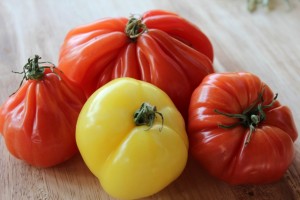
 You’ve seen them lurking in the produce department of the grocery store – those gnarly, cat-faced or cracked tomatoes with deep folds in strange shapes, colors and sizes. They almost seem to watch you as you head toward the cucumbers and peppers. Maybe you even buy them and eat them, but do you know what the term “heirloom” tomato really means?
You’ve seen them lurking in the produce department of the grocery store – those gnarly, cat-faced or cracked tomatoes with deep folds in strange shapes, colors and sizes. They almost seem to watch you as you head toward the cucumbers and peppers. Maybe you even buy them and eat them, but do you know what the term “heirloom” tomato really means?
Many people think heirloom tomatoes are a specific kind of tomato, but heirloom refers to any fruit or vegetable seed that has been saved, grown and passed down by gardeners for generations.
Our ancestors chose to save these tomatoes because of their delicious taste, meaty texture, juiciness or exceptional production in their own gardens. They wanted to share these wonderful cultivars with friends and family because they were just so darn good.
The majority of tomatoes sold in grocery stores today are hybrid tomatoes. (Not to be confused with genetically modified tomatoes.) Plant breeders cross different plants to create a new one with the best features of both parent plants. They are bred to produce specific traits, like disease resistance or thick skins to help them withstand mass shipping. That’s how we get perfectly round, bright red tomatoes that last longer on your kitchen counter. But sometimes those traits come at the expense of the taste.
It takes a long time for hybrid plants to stabilize so that they can actually retain those characteristics, and many of today’s hybrid seeds are relatively new. That explains why seeds from these hybrids can’t produce a mirror image of the parent plants. So, if you plant an Better Boy hybrid tomato plant this year and then later try to plant seeds from those tomatoes, the seeds will not produce tomatoes that are the same as your original plant because the traits will revert.
Heirloom fruit and vegetable seeds (not just tomato seeds) must be open pollinated to produce plants that are just like the parent plant. Open pollinated vegetable varieties reproduce by either:
- cross-pollination — between two plants by insects, wind or water, or
- self-pollination — when male and female parts are contained on the same plant.
Plants like tomatoes, beans and peas are self-pollinating. These are the easiest for home gardeners to save and pass down for generations.
Carrots, squash and corn are cross-pollinating, so they have to be kept separate in the garden to keep the varieties true to the parent.
Experts disagree about how old an heirloom has to be to be considered a true heirloom. The introduction of the first hybrids in 1951 muddied the waters a bit. Varieties can be traced back to old European, Native American, Asian or African crops, some traceable by historic record back to 400 years or more.
Today, you can grow heirloom vegetables in your garden and save or pass along the seeds. It’s easy – just buy and plant heirloom seeds or plants from your local nursery. Make sure they are identified as heirloom varieties.
When the tomatoes are ripe, chop or mash one or two of them in a jar. Then fill the rest of the jar with water and shake it up daily for a week to allow the seeds to separate from the pulp and fall to the bottom of the jar. (Leaving them in the water to ferment helps to kill diseases and germination-inhibiting substances.)
Then rinse and dry the seeds – spread them on a ceramic plate to dry because they will stick to paper towels or wax paper or most other surfaces. Put the plate in a cool, dry spot for a week or two and make sure the seeds are fully dried before placing them in a glass jar for storage. Any residual moisture will lead to mold and mildew. Following these steps will help ensure that they are viable when you plant them.
Some heirloom tomato varieties that will grow well in Central Texas include:
- Purple Cherokee
- Black Krim
- San Marzano
- Brandywine
- Yellow Pear
And the best thing about growing delicious heirloom tomatoes here in Central Texas is that we have two distinct growing seasons, enabling us to enjoy them even longer.

